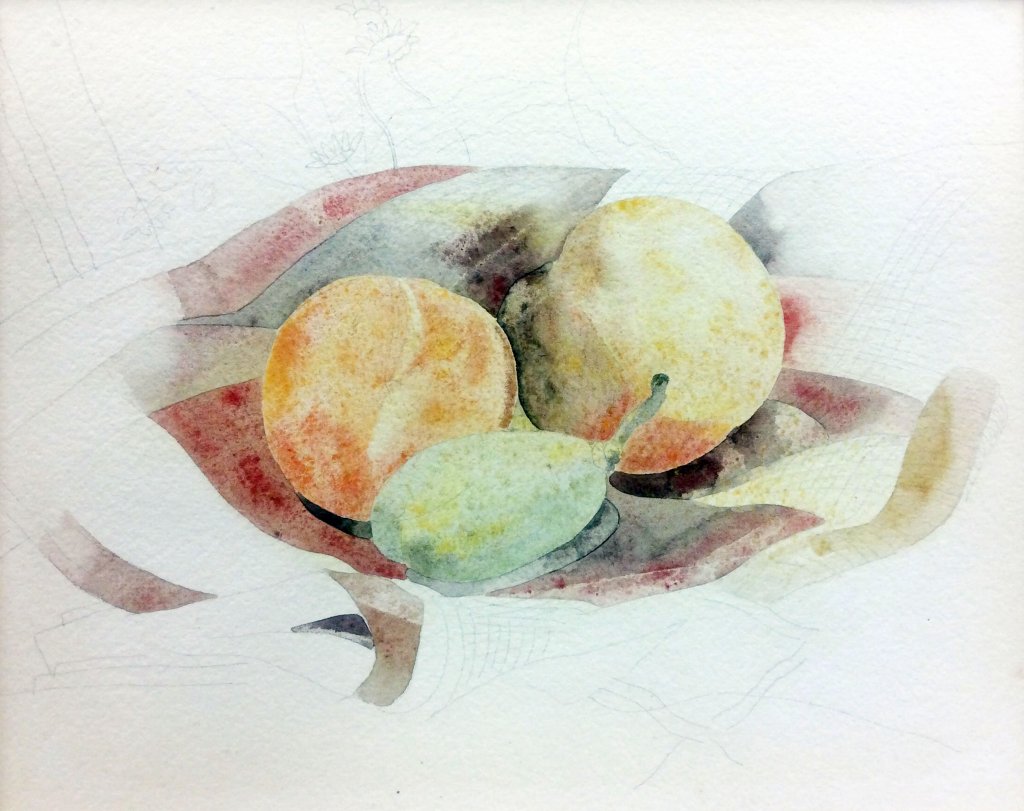Cover Art Commentary: Gregg Hertzlieb on Charles Demuth

Charles Demuth (1883–1935)
Peaches and Fig, ca. 1922–1923
Watercolor and graphite on paper, 8 x 10 inches
Gift of Philipp Brockington
Brauer Museum of Art, 2016.16
The Brauer Museum of Art is grateful to donor and docent Philipp Brockington for enhancing the permanent collection with his gift of a beautiful work on paper by the important American modern artist Charles Demuth. This delicate piece offers the lovely qualities that characterize his observation-based studies while reflecting the precision and sureness of hand seen in his cubist abstractions.
Demuth was a part of the artist circle centered around Alfred Stieglitz in New York in the early twentieth century. Inspired by European figures exploring imaginative representational styles in their art, Demuth and other early moderns such as Georgia O’Keeffe and Arthur Dove sought to acknowledge more frankly the artifice of art and the materiality of art making. Demuth created hard edged, emblematic abstractions that endure as classic American manifestations of a controlled Cubism, but he also created watercolors that appear simultaneously assured and tentative, with gauzy glazes bringing passages into focus that feel fragmentary, like glances from moment to moment. This introduction of time into the essence of the work, a Cubist goal, is a poetic whisper in Demuth’s work that combines careful transcription with an impulse to let the media be self-evident and expressive. He and his colleagues during that period steered public tastes in a direction that still offers creative challenges for artists and viewers.
The watercolor is applied lightly, and the visual texture of colors layering, co-mingling, blooming upon contact is exquisite to behold, breathtaking on its small scale. Materials become metaphorical, as spots of color stain the surfaces of the ripening fruits and mimic their mottled surfaces, even reflecting the inevitable growth of decay. Perhaps a more literal understanding of Cubism does not apply here, in the sense that in this particular work the scene is not fractured to accommodate or indicate multiple points of view on a single picture plane. Instead, diaphanous tissues of color rise from the network of graphite lines in a fashion that feels to viewers like seeing—less in the sense of recording and more in the sense of noticing and observing. Viewers let the modern artist be their guide as they become less focused on heeding impartial likenesses and more centered on letting the artist reveal and transport through use of a vocabulary that fosters rhymes visually and conceptually.
In this humble still life are life and death, paradoxically objectively and personally captured, with the tracks of the artist revealing time and the hand while a moment never to occur again is frozen in time, fluid watercolor strokes arresting blushes on aging fruit. What Demuth presents is a scene and an event, where the artist looked closely at the objects before him and acted as a conduit for the pigment to speak, to mimic, to stave off decomposition while celebrating the visual richness of it. As we are quarantined, Demuth seems to encourage us to look closely at the objects surrounding us. Too, he encourages us to delight in the way that sees analogy in the way things appear, and the way we move and find visual equivalents to express our wonder, fear, appreciation, even bewilderment.
Gregg Hertzlieb is Curator and Director of the Brauer Museum of Art at Valparaiso University and a Contributing Editor to Valparaiso Poetry Review. Hertzlieb is the editor of the books The Calumet Region: An American Place (Photographs by Gary Cialdella), published in 2009, and Domestic Vision: Twenty-Five Years of the Art of Joel Sheesley (2008), as well as a contributor to The Indiana Dunes Revealed: The Art of Frank V. Dudley (2006). He has been awarded the Edward L. Ryerson Traveling Fellowship by the School of the Art Institute in Chicago and a Conant Writing Award for Poetry from Millikin University. His artwork has been exhibited widely, including at the Aron Packer Gallery, August House Studio, the Central School of Art and Design in London, Columbia College, Elgin Community College, the Goodman Theater, Struve Gallery, and the Ellen Firme Gallery.